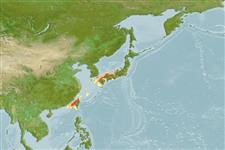>
Eupercaria/misc (Various families in series Eupercaria) >
Sillaginidae (Smelt-whitings)
Etymology: Sillago: From a locality in Australia .
More on author: Gill.
Environment: milieu / climate zone / depth range / distribution range
Ökologie
seewasser; brackwasser demersal; standorttreu; tiefenbereich 0 - 30 m (Ref. 6205). Subtropical; 37°N - 21°N, 117°E - 142°E (Ref. 6205)
Northwest Pacific: southern Japan and Taiwan.
Size / Gewicht / Alter
Maturity: Lm ? range ? - ? cm
Max length : 30.0 cm SL Männchen/unbestimmt; (Ref. 6205)
Rückenflossenstacheln (insgesamt): 13 - 14; Rückenflossenweichstrahlen (insgesamt): 20-22; Afterflossenstacheln 2; Afterflossenweichstrahlen: 22 - 24; Wirbelzahl: 39 - 40. Swim bladder with two posterior extensions. Body is pale brown to dull brown above, lighter below; a faint mid-lateral stripe usually present; dorsal fins dusky terminally with five or six rows of dusky spots on second dorsal fin membranes, other fins hyaline.
Found in tidal flats in the estuary zone near large rivers. Oviparous (Ref. 205). Fishery is declining possibly due to habitat alteration by reclamation and pollution. The flesh is firm and well accepted in Japan (Ref. 6205).
Life cycle and mating behavior
Geschlechtsreife | Fortpflanzung | Ablaichen | Eier | Fecundity | Larven
McKay, R.J., 1992. FAO Species Catalogue. Vol. 14. Sillaginid fishes of the world (family Sillaginidae). An annotated and illustrated catalogue of the sillago, smelt or Indo-Pacific whiting species known to date. Rome: FAO. FAO Fish. Synop. 125(14):87p. (Ref. 6205)
IUCN Rote Liste Status (Ref. 130435)
Bedrohung für Menschen
Harmless
Nutzung durch Menschen
Fischereien: kommerziell; Aquakultur: zukünftige nutzung
Mehr Information
ReferenzenAquakulturAquakultur ProfilZuchtlinienGenetikElectrophoresesVererbbarkeitKrankheitenVerarbeitungNutrientsMass conversion
PartnerBilderStamps, Coins Misc.LauteCiguateraGeschwindigkeitSchwimmstilKiemenoberflächeOtolithsGehirngrößeSehfähigkeit
Tools
Zusatzinformationen
Download XML
Internet Quellen
Estimates based on models
Preferred temperature (Ref.
123201): 17.7 - 24.6, mean 21.4 °C (based on 193 cells).
Phylogenetic diversity index (Ref.
82804): PD
50 = 0.5000 [Uniqueness, from 0.5 = low to 2.0 = high].
Bayesian length-weight: a=0.00575 (0.00272 - 0.01217), b=3.06 (2.89 - 3.23), in cm total length, based on LWR estimates for this Genus-body shape (Ref.
93245).
Trophic level (Ref.
69278): 3.4 ±0.44 se; based on food items.
Widerstandsfähigkeit (Ref.
120179): hoch, Verdopplung der Population dauert weniger als 15 Monate. (Preliminary K or Fecundity.).
Fishing Vulnerability (Ref.
59153): Low to moderate vulnerability (27 of 100).
